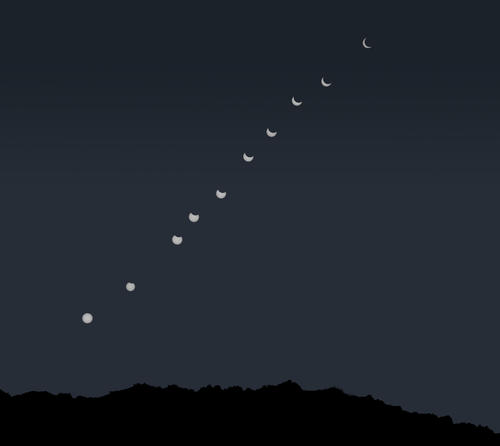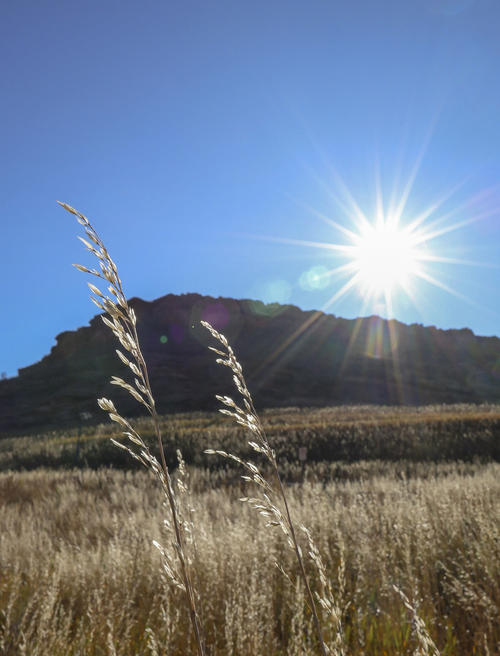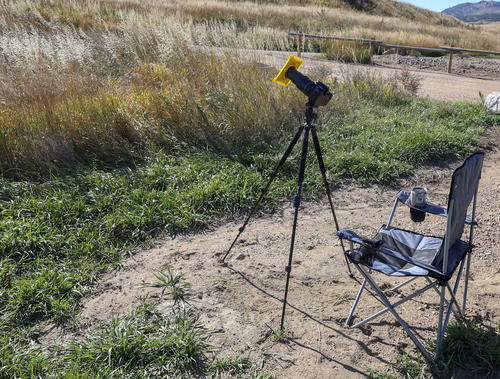Solar Eclipse
Today there was a partial solar eclipse in my area. Having shot the last solar eclipse that went through my town back in 2017 and it being a lot of fun, I decided to try and step up my photography for this one. This solar eclipse was only 76% coverage for where I was which is a lot less than the previous one (96%), but it was still enough of an eclipse to want to go shoot it. The weather was in the mid-30s the entire time that I was out shooting, which ended up being almost 2 hours. That was a little chilly, but it didn't bother me until about an hour in when a slight breeze developed.
My plan was to use 2 of my cameras (my newer R8 and my older T6s). I would use the older T6s to take a wider-angle shot with something in the foreground (part of Bobcat Ridge) and show the path with eh progress of the eclipse. That would require leaving a camera untouched on a tripod for the entire shoot. With my newer R8 camera, I would take close-up shots. Unfortunately, I left my telephoto lens for my R8 camera at home which essentially left me with just my older T6s camera to take photos with. Because of this, I was carefully taking my camera on and off the tripod to take both up close photos by hand but then put it back on the tripod where hopefully everything nothing would get accidently moved. Using one camera for a two camera job didn't go so well.
The eclipse started at 9:15am, peaking at 10:36am, and ending at 12:05pm. The area I chose was Bobcat Ridge. I picked that location because I wanted somewhere that I could have a ridge or mountain in the photo while being able to stay close to my car. I had a lot of gear with me, including two cameras, two tripods, and a camping chair, so not having to haul that around was the primary concern for wanting to stay close to the car. Additionally, I wanted to be close in case I needed to hop in the car to warm up for a few minutes. In hindsight, I do think this was a good choice of location.
Here are a few key takeaways for the next time I'm shooting a solar eclipse:
- For the timelapse photo, the field of view needs to be large enough to capture the whole event. I miscalculated how high the sun would be at the peak of the eclipse, which made stitching the photo together quite difficult. I thought 50mm (on my crop sensor lens) would be great, but it needed to be a little wider than that. a 50mm focal distance would have been perfect on my full-frame camera.
- Bring tape to lock the focal distance if using a non-prime lens.
- Be time-sensitive to taking photos in set intervals. I wasn't great with this which left the spacing between all of the suns very uneven.
- Double-check that you have all the gear you need.
- Don't mess around taking tons of photos with different settings. If it's a clear day, stick with these settings or within one stop of them: f/40, 1/4000, ISO 100 for shade 8 weld glass, f/20, 1/4000, ISO 100 for shade 11

Timelapse of the Eclipse
So this is not a great photo. I could have fixed the alignment/spacing issues in Photoshop, but that's not really the point... I wanted to keep this photo as uneven as it is so that I see it for the next eclipse and do better the next time.

Bright Sun
I had my Canon R8 camera with me, but the only lens I had for it was a 16mm prime lens since I accidentally left the telephoto at home. I figured I'd take a photo with it while I was waiting for the eclipse to do its thing.

Setup for the Morning
My setup consisted of a camera on a tripod, a camping chair, and some warm tea.


